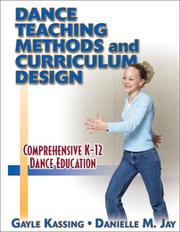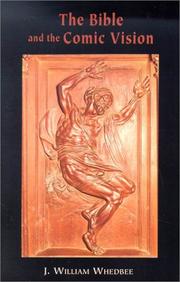| Listing 1 - 10 of 12889 | << page >> |
Sort by
|

ISBN: 9780736002400 Year: 2003 Publisher: Champaign : Human Kinetics,
Abstract | Keywords | Export | Availability | Bookmark
 Loading...
Loading...Choose an application
- Reference Manager
- EndNote
- RefWorks (Direct export to RefWorks)
Inhoudsopgave (verkort) Part I: Dance Pedagogy: What You Need to Know About Teaching and Learning Dance Chapter 1. Envisioning Dance Education Chapter 2. Teaching Dance and Cross-Disciplinary Knowledge Chapter 3. Observing and Analyzing the Teaching and Learning Situation Chapter 4. Guiding Students in Learning DanceChapter 5. Understanding Dance Teaching Methods Chapter 6. Organizing and Managing the Dance Class Chapter 7. Analyzing the Learner and the Learning Environment Chapter 8. Categorizing Dance Forms and Their Artistic Demands Part II: Implementing Dance Pedagogy: What You Need to Do to Create a Dance Curriculum Chapter 9. Developing the Lesson Plan Chapter 10. Selecting the Appropriate Assessment Tools for Dance Chapter 11. Writing and Delivering the Lesson Plan Chapter 12. Creating a Curriculum Chapter 13. Sample Units for Dance Forms
Dans --- Opleiding.
Book
ISBN: 9789042037359 Year: 2013 Volume: 167 Publisher: Amsterdam [etc.] Rodopi
Abstract | Keywords | Export | Availability | Bookmark
 Loading...
Loading...Choose an application
- Reference Manager
- EndNote
- RefWorks (Direct export to RefWorks)
Book
ISBN: 9788269149272 8269149276 Year: 2022 Publisher: Brussels Oslo Varamo Press
Abstract | Keywords | Export | Availability | Bookmark
 Loading...
Loading...Choose an application
- Reference Manager
- EndNote
- RefWorks (Direct export to RefWorks)
Drawing on his experience in the field of contemporary dance, Jeroen Peeters discusses principles, methods and practices that contribute to an understanding of dramaturgy as an experimental, collaborative practice and a material form of thinking. Written from practice, this book reflects a particular history of collaboration and conversation with dance-makers such as Martin Nachbar, Meg Stuart, Vera Mantero, Sabina Holzer, Lisa Nelson, Jennifer Lacey, Chrysa Parkinson, deufert + plischke, Eleanor Bauer, Philipp Gehmacher and many others. Phantasmal archaeology, unfolding material, literal and physical reading, crafting method, articulating process, witnessing and performing not-knowing, naming and ritual destruction, conceptual landscapes, symbolic waste, internal fictions and foreign objects – they may all play a role in creation and in exploring the unfamiliar in pursuit of making sense. And then it got legs is an invitation to think along or against, to discuss those ideas with others or explore them in the studio, and eventually to imagine and devise one’s own methods of research, observation, reflection and creation.
Theatrical science --- Dans. --- Dramaturgie.

ISBN: 9780800634865 0800634861 Year: 2002 Publisher: Philadelphia: Fortress Press,
Abstract | Keywords | Export | Availability | Bookmark
 Loading...
Loading...Choose an application
- Reference Manager
- EndNote
- RefWorks (Direct export to RefWorks)
Book

Year: 2017 Publisher: S.l. BelAir classiques
Abstract | Keywords | Export | Availability | Bookmark
 Loading...
Loading...Choose an application
- Reference Manager
- EndNote
- RefWorks (Direct export to RefWorks)
Book
ISBN: 9060324625 Year: 1969 Publisher: Leipzig : Amsterdam : Andersen Nexö ; .R. Grüner,
Abstract | Keywords | Export | Availability | Bookmark
 Loading...
Loading...Choose an application
- Reference Manager
- EndNote
- RefWorks (Direct export to RefWorks)
Sports --- Dans l'art
Book
ISBN: 9782503593579 Year: 2022 Publisher: Turnhout Brepols
Abstract | Keywords | Export | Availability | Bookmark
 Loading...
Loading...Choose an application
- Reference Manager
- EndNote
- RefWorks (Direct export to RefWorks)
Museum studies today understand museums as symbolic spaces shaping, staging, and disseminating images and imaginaries as well as discourses of knowledge and power. As they try to encompass, gather and classify all times and places within one purpose-built building, they may be theorised with Michel Foucault as “heterotopias,” like theatre and libraries, that is to say spaces both within and without time and place. As such, they invent specific discourse and partake of story telling and narrativisation. This collective volume in English and French adopts the perspective of literary studies to investigate the way museums, be they real or imaginary, have been represented, reminisced, or fictionalised in many literary genres from the eighteenth-century to the early twenty-first century. It explores the ways fiction, children’s picture story books, and grey literature mediatise and fictionalise art museums, archaeological or Egyptological museums, war museums and museum-like spaces such as World exhibitions, private collections, or, arguably, hoarders’ houses, sometimes theorising both literature and museums as discursive spaces producing imaginaries. It includes diachronical, comparative, generical overviews as well as case studies and interviews that together map out the varied modes of appropriation and figuration of museums by fiction, gothic, horror and fantasy, memoirs, reviews, children’s literature, and bande dessinée.
Book
Year: 1993 Publisher: Universität des Saarlandes [Saarbrücken],
Abstract | Keywords | Export | Availability | Bookmark
 Loading...
Loading...Choose an application
- Reference Manager
- EndNote
- RefWorks (Direct export to RefWorks)
Book
Year: 1973 Publisher: The Hague : Mouton,
Abstract | Keywords | Export | Availability | Bookmark
 Loading...
Loading...Choose an application
- Reference Manager
- EndNote
- RefWorks (Direct export to RefWorks)
Book
Year: 1966 Publisher: Seattle, London : University of Washington Press,
Abstract | Keywords | Export | Availability | Bookmark
 Loading...
Loading...Choose an application
- Reference Manager
- EndNote
- RefWorks (Direct export to RefWorks)
| Listing 1 - 10 of 12889 | << page >> |
Sort by
|

 Search
Search Feedback
Feedback About UniCat
About UniCat  Help
Help News
News